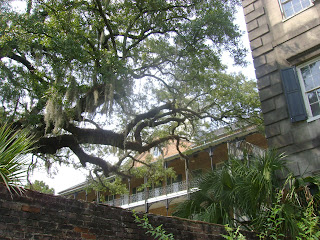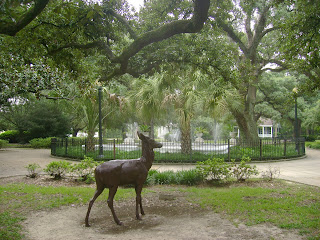Monday, November 21, 2011
DeTonti Square Historic District
DeTonti Square Historic District contains the largest concentration of antebellum homes within the city. Brick townhouses with cast iron galleries predominate though a few fine examples of early "creole" cottages can also be found. Here one can see the homes of successful merchants and statesman, as well as Napoleonic and Saint Dominguan Refugees who re-built their lives in America. The district was named after the early explorer and fellow Italian, Henri Detonti, who, along with Iberville and Bienville helped found Mobile.
Tuesday, November 8, 2011
Lemon Trees
Price of lemons at Wal-Mart - $0.49 each
Price of lemons at Winn-Dixie - $0.99 each
Growing your own Lemons in your backyard...Priceless
Many things convey the image of life on the gulf coast. Mythical pirates, Jimmy Buffett, and palm trees to name a few. But there is something special about having your own lemon tree. It is one of those tangible items that reminds you that you are living in paradise. Our youthful tree has done well despite the record cold temperatures the past two seasons. It has actually fared better than some of our more cold hardy citrus. It produced 26 lemons this year and next year I'm hoping for a bumper crop!
Price of lemons at Winn-Dixie - $0.99 each
Growing your own Lemons in your backyard...Priceless
Many things convey the image of life on the gulf coast. Mythical pirates, Jimmy Buffett, and palm trees to name a few. But there is something special about having your own lemon tree. It is one of those tangible items that reminds you that you are living in paradise. Our youthful tree has done well despite the record cold temperatures the past two seasons. It has actually fared better than some of our more cold hardy citrus. It produced 26 lemons this year and next year I'm hoping for a bumper crop!
Saturday, October 1, 2011
A Canopy of Oaks
Mobile is known by airline pilots as the "city under the trees" mostly due to the oak trees that line our streets. The summer afternoon thunderstorms and late winter/early spring showers that make Mobile the rainiest city in America also help create the perfect environment for growing monster-sized oak trees. Though the trees used to line Mobile's streets in the early years were the chinaberry tree (also known as the Pride of India) due to its fast growth, they were soon replaced by the native live oaks. Today, virtually every major corridor of the old city has a live oak canopy.
 |
| Bienville Square |
 |
| Government Street |
 |
| Old Shell Road |
 |
| Washington Square |
 |
| "Duffy" Oak, Caroline Avenue |
 |
| "Twelve Oaks", Palmetto Street near Square |
Thursday, September 15, 2011
Spring Hill College
Spring Hill College, founded in 1830, is the oldest Catholic college in the South. Cardinal Joseph Fesch, Napoleon's Uncle and said to be the only member of the Clergy trusted by Napoleon, was a major benefactor of the college. In addition to funding the school, Fesch, known for his art collections, provided important works of art to Spring Hill. Unfortunately, these were lost when the original building burned. The current administration building was designed by William Freret of New Orleans, a Spring Hill Alumnus. The school was strategically located by Bishop Portier midway between the large catholic populations of Saint Augustine and Pensacola to the east and New Orleans and other towns of Louisiana to the west. The location on the hill about eight miles west of Mobile was also said to be free of yellow fever. In the early years, the school was attended by the well-born Creoles of the Gulf South as well as the Caribbean and Central America. Paul Morphy is one of the famous early attendees of the college and, during the Civil War, children of prominant families such as Semmes, Maury, Taylor, Beauregard, and Bullock attended the school. Two brothers from Cuba, Ernest and Nemesio Guillo, attended Spring Hill in 1860 and later introduced baseball to Cuba. I've also heard that at one time during the early 20th century, a majority of the members of the Mexican Supreme Court were Spring Hill Alumni. To this day, most of the students come from the old French and Spanish colonial towns from Florida through Louisiana and along the Mississippi River up to Illinois. Spring Hill will always be close to my heart because it was one of my first experiences with study abroad. It was here that I studied English as a Foreign Language for a Summer Course during high school.
 |
| Original Building (1831) Designed by Claude Beroujon |
 |
| Administration Building (1869) by Freret |
 |
| St. Joseph's Chapel |
 |
| Stewartfield (1842) with Avenue of Oaks |
 |
| Byrne Hall and Soccer Field |
 |
| Sodality Chapel (c. 1850) |
Friday, September 9, 2011
Roses of Old Mobile
The Vineland Nursery was established by C.C. Langdon in the 1850's. It was located north of Mobile near Citronelle, Alabama and, I am told, ancient camellias can still be found on the site. The 1858-59 Vineland Nursery catalog included a listing of a dozen varieties of roses that were sold that year. They were as follows:
- Augusta Climber
- Cornice De Marseilles
- Cloth of Gold
- Duchess of Sutherland
- Giant of Battles
- La Marque
- La Reine
- Luxembourg
- Octavie
- Pope Pius
- Solfataire
- Souvenir de la Malmaison
I have found what I believe to be eight of the varieties listed in the catalog and have included a few of them in the photos below.
 |
| Duchess of Sutherland with St Joseph's Lilly |
 |
| Geant de Batailles |
 |
| Souvenir de la Malmaison |
 |
| La Marque, Climbing |
 |
Saturday, August 27, 2011
Visitation Monastery
The Convent of the Visitation on Spring Hill Avenue was first established in 1833 by Bishop Portier and constructed with the help of his Master Builder Claude Beroujon. It provides one of the most beautiful settings in Mobile. It served as a school from its beginnings until 1953 when it was converted to a retreat house. Students came not just from Mobile but throughout the area and even Latin America. The surviving buildings were constructed between 1854 and 1895. The chapel dedicated to the Sacred Heart was realized through the financial assistance of Madame Camille Marguerite De Poorter and the McGill brothers, Felix and Arthur in 1895. Harrod and Andry of New Orleans served as architects. In 1953 a Candy Shop was established and the Nuns continue to make and sell their delicious "Heavenly Hash" along with linens and other souvenirs at the gift shop.
Friday, August 19, 2011
Washington Square, Oakleigh Garden District
I recommend to anyone visiting Mobile that they take a tour of the Oakleigh Garden District. In the heart of the district is Washington Square which was deeded to the city as a public promenade in 1850. The homes facing the square were built just after the Civil War and represent some of the best examples of italianate and victorian architecture in the city.
Subscribe to:
Posts (Atom)











































